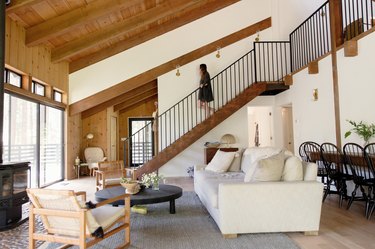The stair riser height is very important when designing and installing a new staircase. A step that is too tall will be dangerous, while a step too low can make the stairway too long. Both stairs that are too high and too low can result in a staircase that is uncomfortable to climb. But what defines what is too high and what is too low will largely vary based on how long the horizontal part of the stair, know as the run, stretches.
The Importance of Stair Dimensions
Video of the Day
Ideally, a step should be the right height and length so each step matches an average person's stride. In other words, a person should be able to take one step forward with their usual gait and end up with their foot on the next step without straining or stretching.
Video of the Day
When the stairs are too high, they require a lot more concentration and effort to climb and become more dangerous. Staircases with treads that are too narrow will be dangerous and uncomfortable for those with large feet. A staircase with treads that are too wide will take up too much space and be uncomfortable to climb as each step will either require two strides or one particularly long stride to complete.
Standard Step Height
On average, American architects have used a standard stair height of 7.5 inches. On stairs built inside, the average tread width is 9 inches, while outside treads have an average width of 11 inches.
Although not the current average, one study by the National Library of Medicine looked a small deviation between stair heights (rises) and lengths (runs) and how they affected the climbing ability of men, women and people of all ages. Researchers found that the ideal step height is 7.2 inches and the ideal tread width should be anywhere between 11 and 12 inches.
Building codes in many areas define maximum step height and minimum tread width, but in areas where it is not defined, Council of American Building Officials and International Code Council both recommend the rise to be no more than 7.75 inches and runs to be no less than 10 inches. Given that 4,000 people in the United States die from falling down stairs every year, it is a good idea to stick to these safety guidelines.
When designing a staircase for use in a home, designers need to keep in mind not just the comfort of those traversing the stairwell, but also how much space the stairs will take up. A staircase that goes up 12 feet and has steps that are 7.5 inches high will take up around 13 feet and 6 inches if it has 9-inch wide treads, but making it with 11-inch treads will take up around 16 feet and 6 inches. Not all houses have space for those extra 3 feet of stairs, so the amount of floor space a stairway can take up also needs to be taken into account when deciding on the right stair dimensions.
Designing a Comfortable Stairway
There are two calculations that can help determine whether a stairway's rise and run will feel comfortable during use. The total length of the tread rise plus the width—or run—(r+R) should equal around 18 inches with no more than a 1-inch deviation. Also, twice the rise plus the run (2r+R) should be equal to 25 inches, also with a 1-inch deviation.
It is useful to look at both rules when considering the comfort of a stairway. A staircase with an 8-inch rise and an 8-inch run, for example, will not be comfortable because the treads are too narrow for many people's feet to fit on completely. Using the calculations to determine if it is safe and comfortable, you can see the total of the rise and run is 16, making it far too low for the first rule. At the same time, this stairway would measure up just fine with the second rule as it would come out to 24 using the second equation.
On the other hand, a stair that is 5 inches high and 13 inches long might be acceptable, according to building safety suggestions. The total of the rise plus the run is 18, which meets the ideal, according to the first rule. But it would be slightly uncomfortable based on the second rule, given that double the rise plus the run equals 23.
A more ideal step that is 7 inches high with an 11-inch tread width gives a total run plus rise sum of 18 and a total double rise plus run sum of 25, making it meet both requirements perfectly.
